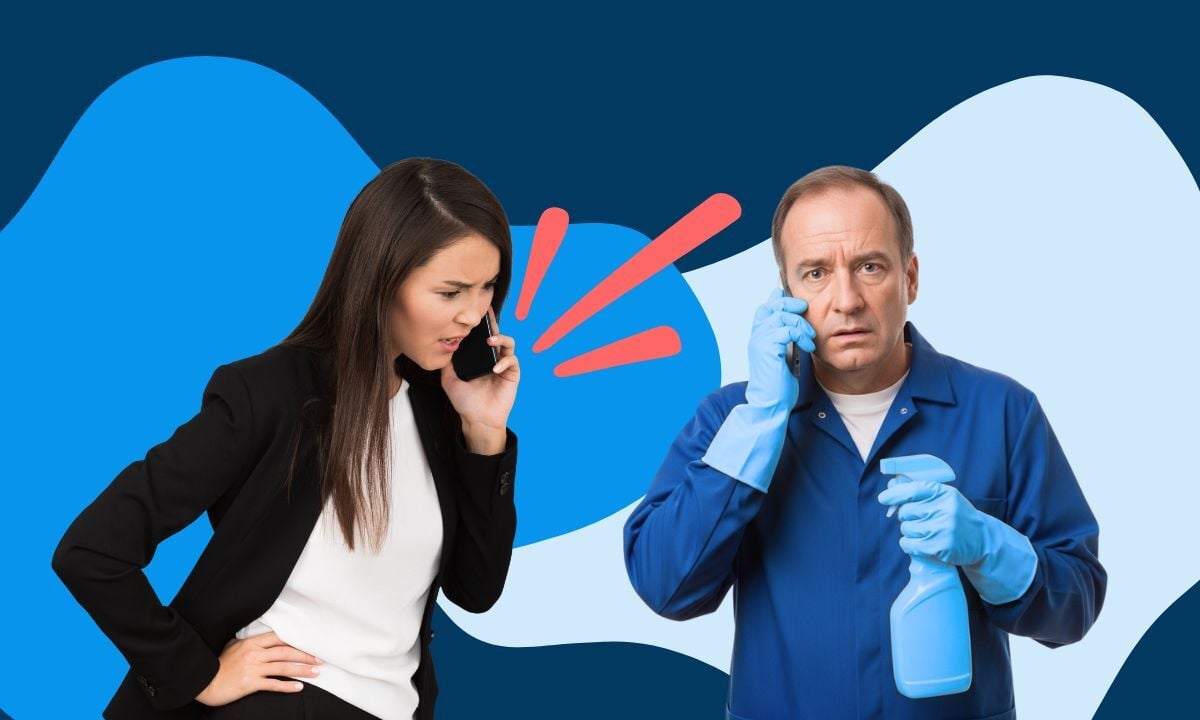How to Deal with Unhappy Commercial Cleaning Clients (and Turn Things Around)

No matter how reliable your team is or how high your standards are, at some point, something will go wrong. A missed task. A no-show cleaner. A frustrated client.
When that happens, your response can either cost you the contract—or strengthen the relationship.
In this post, we’ll show you exactly how to handle client complaints in your commercial cleaning business, using a proven framework that builds trust, repairs issues, and even improves retention over time.
Common Reasons Clients Get Frustrated in Commercial Cleaning
If you've been in the business for any length of time, you've likely heard complaints like:
-
"The cleaner didn’t show up."
-
"The garbage wasn’t taken out."
-
"Something was damaged or left messy."
-
"Tasks were rushed or incomplete."
-
"We had to point it out—again."
These moments are frustrating for you and the client—but they’re also an opportunity to demonstrate leadership, fix communication gaps, and make your client feel confident they chose the right company.
Let’s walk through four best practices from Swept founder Michael Brown, who built and scaled a successful cleaning company before launching Swept.
Step 1: Listen First—Don’t Defend
As a cleaning business owner, your instinct is probably to jump into problem-solving mode. But when a client is upset, your first job is emotional, not logistical.
Clients don’t want excuses. They want to feel heard.
Start by listening fully. Let them explain what happened. Resist the urge to explain or justify anything right away. When you lead with empathy, not defensiveness, you’re already ahead of most competitors.
Step 2: Repeat It Back and Show You Understand
Once they’ve shared their side, repeat it back to them—word for word if you can.
“So what I’m hearing is that the cleaner forgot to lock up three times this month, and that’s made your staff concerned about security. That’s completely understandable, and I’m really sorry that we’ve put you in that position.”
Repeating their concerns builds trust and shows you’re truly listening. This is your opportunity to build a human connection—not just solve a cleaning task.
Step 3: Find (and Follow Through on) the Right Solution
Only once you fully understand the issue and the emotional context behind it should you move into the solution.
That might look like:
-
Scheduling a re-clean or inspection
-
Offering a discount or add-on
-
Reassigning the cleaner
-
Creating a custom checklist (Try our free Janitorial Checklist Template)
-
Improving communication protocols using tools like Swept
Important: You don’t need to solve everything on the spot. But you do need to show ownership and a clear plan of action.
And make sure this isn’t a one-off fix. Build a system so you hear about issues before the client has to raise them again.
Step 4: Follow Up and Build Long-Term Trust
This step is often skipped—but it’s where long-term retention lives.
After implementing the fix, follow up with a phone call, in-person visit, or email (based on your client’s preference). The key is to:
-
Acknowledge the issue again
-
Share what you learned or changed internally
-
Thank them for giving you the chance to improve
Here’s an example:
“We spoke with the cleaner and found out she felt unsafe taking the garbage out late at night. We've changed the schedule so she now does that task at the beginning of her shift—and we've assigned a second cleaner to that site for support. Thanks again for flagging this. We really appreciate your partnership.”
When you follow up with honesty and a clear plan, you help your client feel confident they hired a team that owns its mistakes and makes things right—something their own team will notice, too.
What This Does for Your Cleaning Business
When you respond to complaints the right way:
-
You keep valuable contracts
-
You reduce client churn
-
You gain loyalty and referrals
-
You build a reputation for reliability—even when things go wrong
In fact, research shows that clients often trust you more after a complaint is handled well.
Final Thoughts: Great Service Isn’t Perfect—It’s Accountable
Every cleaning business will make mistakes. What sets you apart is how you handle them.
Lead with empathy. Fix issues proactively. Build systems that catch problems early. And keep showing your clients why they made the right choice by hiring you.
Want to Build Stronger Client Communication?
Clear communication builds trust—and trust keeps clients.
Here are a few free tools to help you prevent issues, demonstrate quality, and keep clients in the loop:
-
Janitorial Cleaning Checklist – Set clear expectations for every site so nothing gets missed.
-
Cleaning Schedule Template – Keep your team and your clients aligned on what’s happening and when.
-
Inspection Report with Photo Documentation – Provide visual proof of quality and catch issues early.
-
Client Satisfaction Survey Template – Gather feedback before small concerns become bigger problems.
Ready to deliver better service, communicate more clearly, and retain more clients?


